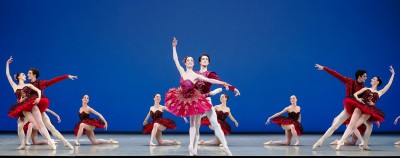Watching dance on the big screen has many pleasures. Perhaps the biggest joy these days is being able to see, so soon after a premiere, works presented by major companies from the other side of the world. The recent screening in Australia of a filmed performance from the Paris Opera Ballet is a case in point. Filmed just days after the opening at the Opéra Bastille, this program brought together Le palais de cristal from George Balanchine and Daphnis et Chloé, a new work from Benjamin Millepied, shortly to take over at POB from Brigitte Lefèvre.
Le palais de cristal opened the program. Made by Balanchine in 1947 especially for POB, it is better known around the world in a revised form as Symphony in C. One of the aspects of the filming that I especially liked was that the recording was often made from a position high up in the theatre. As a result the precise and very formal patterns Balanchine created for Le palais de cristal were easily appreciated. But we were also given many occasions to see the dancers as if we were sitting in the best seats in the house. The closer shots provided a good view of the costumes, newly designed by Christian Lacroix. Some have seen them as overly decorative. I thought they suited the work and I was especially fascinated by the tutus for the corps de ballet. They seemed to have a hoop-like addition to the skirt that gave them a kind of puff-ball look.
But of course the highlight was the dancing. It is always amazing to see the precision of the dancers of the Paris Opera Ballet. Never a foot wrong! One dancer from amongst the soloists stood out. Not knowing the dancers as much as I would like I don’t know her name but she was, I think, of Japanese extraction. What appealed to me was the way she stepped forward into the space in front of her, generously, and the way her movements seemed to have an ongoing existence. A lift of the arm didn’t finish at the finger tips but looked as though it continued through space. Beautiful.

Daphnis et Chloé had a certain fascination, given that I remain an admirer of Graeme Murphy and his works made for Sydney Dance Company made over a thirty year period between the mid 1970s and the early 2000s. Murphy’s Daphnis and Chloe, made in 1980 and designed by Kristian Fredrikson, could not have been further apart from that of Millepied. But I have no wish to make a comparison, just a comment on what a different take it was, visually, choreographically and in terms of portrayal of the narrative.
I found Millepied’s work hard to follow. The choreography certainly flowed and there were some lovely moments of mass movement from the corps. But the storyline wasn’t really conveyed strongly. It was something of a cross between a story ballet and an abstraction, but in the end neither. The standout dancer was François Alu as Bryaxis. Millepied gave him a solo full of spectacular jumps and turns and he rose to the occasion.
Daniel Buren’s large, brightly coloured shapes that descended from the flies and then withdrew back upwards were beautiful in themselves but they didn’t help with understanding the story. In the interview Buren gave to Mme Lefèvre prior to the start of the performance he talked about voids and the idea of occupying space. He is a conceptual artist but the concept he was aiming for with his design to my mind didn’t help the ballet. And why, at the conclusion of the ballet, were the dancers’ costumes transformed into colour from the white they were throughout the rest of the work? At the same time, Buren’s shapes were removed only to reappear a little later for a curtain call. The whole thing escaped me. I wondered whether, for this work, I would have been more satisfied had I been in the theatre watching live.
Despite my problems with Daphnis et Chloé, it is always a huge pleasure watching Paris Opera Ballet performances. The practice of filming live and then transmitting around the world is a great initiative. May it continue.
Michelle Potter, 30 July 2014